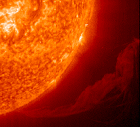|   SPACE WEATHER SPACE WEATHER
Current
Conditions
Solar Wind
velocity: 457.0 km/s
density:3.9 protons/cm3
explanation | more data
Updated: Today at 2248 UT
X-ray Solar Flares
6-hr max: C2 1650 UT Apr25
24-hr: M2 1350 UT Apr25
explanation | more data
Updated: Today at 2250 UT
Daily Sun: 25 Apr '01 
The returning sunspot 9393 (also known as 9433) has a twisted delta magnetic field that likely harbors energy for strong M-class or even X-class solar flares.
Sunspot Number: 175
More about sunspots
Updated: 24 Apr 2001
Radio Meteor Rate
24 hr max: 28 per hr
Listen to the Meteor Radar!
Updated: 25 Apr 2001 Interplanetary Mag. Field
Btotal: 8.2 nT
Bz: 1.8 nT south
explanation | more data
Updated: Today at 2248 UT Coronal Holes:

A coronal hole stretching northward from the Sun's south pole is sending a solar wind stream toward Earth that could arrive by mid-week. Image credit: Yohkoh Soft X-ray Telescope.
More about coronal holes
 SPACE WEATHER SPACE WEATHER
NOAA
Forecasts
Solar Flares: Probabilities for a medium-sized (M-class) or a major (X-class) solar flare during the next 24/48 hours are tabulated below.
Updated at 2001 Apr 25 2200 UT
| FLARE | 24 hr | 48 hr | | CLASS M | 80 % | 80 % | | CLASS X | 25 % | 25 % |
Geomagnetic Storms: Probabilities for significant disturbances in Earth's magnetic field are given for three activity levels: active, minor storm, severe storm
Updated at 2001 Apr 25 2200 UT Mid-latitudes | 24 hr | 48 hr | | ACTIVE | 10 % | 10 % | | MINOR | 05 % | 05 % | | SEVERE | 01 % | 01 % |
High latitudes | 24 hr | 48 hr | | ACTIVE | 20 % | 20 % | | MINOR | 10 % | 10 % | | SEVERE | 01 % | 01 % |

Web server provided by
VPS Hosting
| What's Up in Space -- 25 Apr 2001
Subscribe to Space Weather News! GROWING FLARE THREAT: Active region 9393 (aka 9433) continues to grow and now covers an area equivalent to more than six planet Earths. The big spot has a twisted beta-gamma-delta magnetic field that likely harbors energy for X-class solar flares. Three weeks ago sunspot 9393 unleashed the most powerful solar flare ever recorded. That's unlikely to happen a second time, but the active region nevertheless bears watching.  SOLAR LOOP: Late Monday, the Solar and Heliospheric Observatory spotted an enormous prominence just before it collapsed over the Sun's southwestern limb. The event hurled a bright coronal mass ejection (CME) into space -- but not toward Earth. Click here to view a 400 kb animation of the CME. In the movie, the star-like object moving away from the Sun's southeast limb is the planet Mercury. SOLAR LOOP: Late Monday, the Solar and Heliospheric Observatory spotted an enormous prominence just before it collapsed over the Sun's southwestern limb. The event hurled a bright coronal mass ejection (CME) into space -- but not toward Earth. Click here to view a 400 kb animation of the CME. In the movie, the star-like object moving away from the Sun's southeast limb is the planet Mercury.
WEB LINKS: NOAA FORECAST | GLOSSARY | SPACE WEATHER TUTORIAL | LESSON PLANS | BECOME A SUBSCRIBER |  
Potentially Hazardous Asteroids (PHAs) are space rocks larger than approximately 100m that can come closer to Earth than 0.05 AU. None of the known PHAs are on a collision course with our planet, although astronomers are finding new ones all the time. [more]
On 25 Apr 2001 there were 307 known Potentially
Hazardous Asteroids April 2001 Earth-asteroid encounters | Object | Date (UTC) | Miss Distance | | 2001 GT2 | 2001-Apr-01 00:09 | 0.0454 AU | | 2001 HB | 2001-Apr-02 04:21 | 0.0323 AU | | 2001 FA58 | 2001-Apr-02 07:56 | 0.1128 AU | | 1986 PA | 2001-Apr-03 01:06 | 0.1465 AU | | 2000 EE104 | 2001-Apr-12 20:37 | 0.0822 AU | | 2001 GR2 | 2001-Apr-18 04:07 | 0.0761 AU | | 2001 GQ2 | 2001-Apr-27 12:00 | 0.0199 AU | 
- TOTAL LUNAR ECLIPSE: On Jan. 9, 2001, the full Moon glided through Earth's copper-colored shadow. [gallery]
- CHRISTMAS ECLIPSE: Sky watchers across North America enjoyed a partial solar eclipse on Christmas Day 2000 [gallery]
- LEONIDS 2000: Observers around the globe enjoyed three predicted episodes of shooting stars. [gallery]
 Feb. 21, 2001: Nature's Tiniest Space Junk -- Using an experimental radar at the Marshall Space Flight Center, scientists are monitoring tiny but hazardous meteoroids that swarm around our planet. Feb. 15, 2001: The Sun Does a Flip -- NASA scientists who monitor the Sun say our star's enormous magnetic field is reversing -- a sure sign that solar maximum is here. Jan. 25, 2001: Earth's Invisible Magnetic Tail -- NASA's IMAGE spacecraft, the first to enjoy a global view of the magnetosphere, spotted a curious plasma tail pointing from Earth toward the Sun. Jan. 4, 2001: Earth at Perihelion -- On January 4, 2001, our planet made its annual closest approach to the Sun. Dec. 29, 2000: Millennium Meteors -- North Americans will have a front-row seat for a brief but powerful meteor shower on January 3, 2001. Dec. 28, 2000: Galileo Looks for Auroras on Ganymede -- NASA's durable Galileo spacecraft flew above the solar system's largest moon this morning in search of extraterrestrial "Northern Lights" Dec. 22, 2000: Watching the Angry Sun -- Solar physicists are enjoying their best-ever look at a Solar Maximum thanks to NOAA and NASA satellites. MORE SPACE WEATHER HEADLINES |

